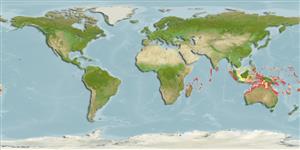>
Ovalentaria/misc (Various families in series Ovalentaria) >
Pomacentridae (Damselfishes) > Pomacentrinae
Etymology: Pomacentrus: Greek, poma, -atos = cover, operculum + Greek, kentron = sting (Ref. 45335).
More on author: Tanaka.
Environment: milieu / climate zone / depth range / distribution range
Ökologie
seewasser riff-verbunden; ozeanodrom (Ref. 51243); tiefenbereich 3 - 35 m (Ref. 1602). Tropical; 10°N - 25°S
Indo-West Pacific: Maldives (Ref. 30829) and Sri Lanka to Vanuatu, north to southern Japan; south to northwestern Australia and New Caledonia.
Size / Gewicht / Alter
Maturity: Lm ? range ? - ? cm
Max length : 11.0 cm TL Männchen/unbestimmt; (Ref. 90102)
Rückenflossenstacheln (insgesamt): 13; Rückenflossenweichstrahlen (insgesamt): 15-16; Afterflossenstacheln 2; Afterflossenweichstrahlen: 15 - 16.
Adults are found in sandy areas of both lagoon and seaward reefs. They occur in small groups with outcrops of soft coral patches or gorgonians, usually in depths over 20 m (Ref. 48636). Feed primarily on zooplankton. Oviparous, males guard the nest (Ref. 59303). Eggs are demersal and adhere to the substrate (Ref. 205). Diurnal species (Ref. 54980; 113699).
Life cycle and mating behavior
Geschlechtsreife | Fortpflanzung | Ablaichen | Eier | Fecundity | Larven
Courtship behavior during breeding includes signal jumps, enticement, chasing and skimming (Ref. 59303).
Allen, G.R., 1991. Damselfishes of the world. Mergus Publishers, Melle, Germany. 271 p. (Ref. 7247)
IUCN Rote Liste Status (Ref. 130435)
Bedrohung für Menschen
Harmless
Nutzung durch Menschen
Aquarium: Kommerziell
Mehr Information
ReferenzenAquakulturAquakultur ProfilZuchtlinienGenetikElectrophoresesVererbbarkeitKrankheitenVerarbeitungNutrientsMass conversion
Tools
Zusatzinformationen
Download XML
Internet Quellen
Estimates based on models
Preferred temperature (Ref.
123201): 24.7 - 28.9, mean 27.6 °C (based on 388 cells).
Phylogenetic diversity index (Ref.
82804): PD
50 = 0.5000 [Uniqueness, from 0.5 = low to 2.0 = high].
Bayesian length-weight: a=0.01479 (0.00642 - 0.03409), b=3.00 (2.80 - 3.20), in cm total length, based on LWR estimates for this (Sub)family-body shape (Ref.
93245).
Trophic level (Ref.
69278): 2.7 ±0.31 se; based on food items.
Widerstandsfähigkeit (Ref.
120179): hoch, Verdopplung der Population dauert weniger als 15 Monate. (Preliminary K or Fecundity.).
Fishing Vulnerability (Ref.
59153): Low vulnerability (10 of 100).
Nutrients (Ref.
124155): Calcium = 113 [64, 180] mg/100g; Iron = 0.814 [0.521, 1.255] mg/100g; Protein = 18.6 [17.5, 19.5] %; Omega3 = 0.152 [0.098, 0.230] g/100g; Selenium = 23.9 [14.4, 41.7] μg/100g; VitaminA = 131 [46, 371] μg/100g; Zinc = 2.07 [1.46, 2.82] mg/100g (wet weight);
